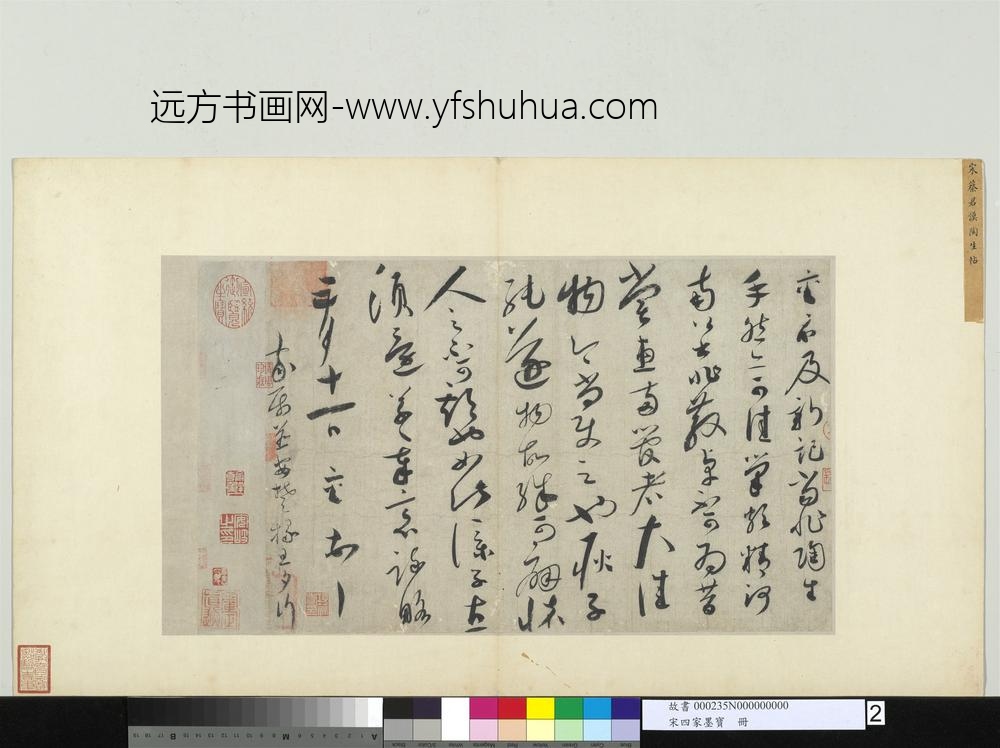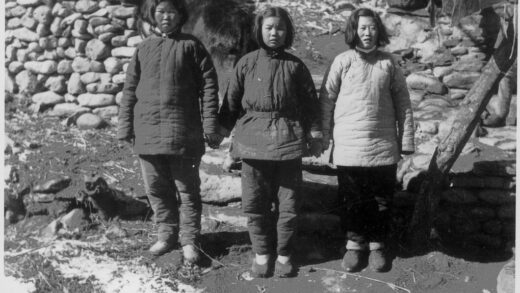【作品基本信息】
| 作者 | 蔡襄 |
| 品名 | 宋四家墨宝册-书尺牍 |
| 朝代 | 北宋 |
| 文件大小 | 17.99MB |
| 分辨率(DPI) | 300×300 |
| 像素大小 | 2831×2119 |
| 尺寸(CM) | 23.96×17.94 |
| 作品数量 | 1 |
| 作品收藏 | 台北故宫博物院 |
| 图片格式 | 默认提供TIF和JPG两个版本 |
基本数据
| 藏品类型 | 书法 |
| 品名 | 宋四家墨宝 册 宋蔡襄书尺牍 Letter (“Taosheng”) |
| 分类 | 法书 |
| 作者 | 蔡襄;Cai Xiang |
| 书体 | 草书 |
| 数量 | 一幅 |
| 作品语文 | 汉文 |
| 释文 | 襄示及新记。当非陶生手。然亦可佳。笔颇精。河南公书。非散卓不可为。昔尝惠两管者。大佳物。今尚使之也。耿子纯遂物故。殊可痛怀。人之不可期也如此。仆子直须还。草草奉意疎略。正月十一日。襄顿首。家属并安。楚掾。旦夕行。 |
典藏尺寸
| 【位置】 | 【尺寸】(公分) |
| 本幅 | 29.8×50.8 |
质地
| 【质地位置】 | 【质地】 |
| 本幅 | 纸 |
题跋数据
| 【题跋类别】 | 【作者】 | 【位置】 | 【款识】 | 【书体】 | 【全文】 |
| 题签 | 裱纸 | 蔡君谟陶生帖。 |
印记资料
| 【印记类别】 | 【印记】 |
| 鉴藏宝玺 | 宣统御览之宝 |
| 收传印记 | 长(半印) |
| 收传印记 | 仪周珍藏 |
| 收传印记 | 项笃寿印 |
| 收传印记 | 朝鲜人 |
| 收传印记 | 安岐之印 |
| 收传印记 | 无恙 |
| 收传印记 | 审定真迹 |
| 收传印记 | 子孙(半印) |
| 收传印记 | (六印模糊不辨) |
参考数据
| 【类别】 | 【参考数据】 |
| 收藏着录 | 石渠宝笈续编(养心殿),第二册,页1097 |
| 收藏着录 | 故宫书画录(第三卷),第一册,页141 |
| 收藏着录 | 故宫历代法书全集,第十一册,页4-37、186-193 |
| 参考书目 | 1.何炎泉,〈宋四家墨宝 册 宋蔡襄书尺牍〉,收入林柏亭主编,《大观-北宋书画特展》(台北:国立故宫博物院,2006年初版一刷),页434-441。 2.本社,〈宋蔡襄陶生帖〉,《故宫文物月刊》,第80期(1989年11月),页1。 3.曹宝麟,〈蔡襄皇佑三年所作三帖考 之 陶生帖〉,《故宫文物月刊》,第130期(1994年1月),页49-65。 4.何炎泉,〈蔡襄〈陶生帖〉与北宋散卓笔〉,《故宫文物月刊》,第280期(2006年7月),页40-47。 5.〈书尺牍(陶生帖)〉,收入何传馨、陈阶晋、何炎泉编,《故宫法书新编 (八) 宋 蔡襄墨迹》(台北:国立故宫博物院,2011年九月初版一刷),页18-21。 |
| 内容简介(中文) | 蔡襄(1012-1067),字君谟,福建仙游人。书法学虞世南、颜真卿,兼取晋人法。帖中用笔粗细变化较大,线条外缘爽朗利落,末笔出锋常露笔心,故推测书写此札之笔应为健毫,外型短胖且含硬挺的心毫,接近记载中的散卓笔。北宋时以诸葛家散卓笔为最,初以粟鼠尾捻心,后经梅尧臣引进苍鼠须后,受到杜衍、蔡襄等文人的喜爱。文中所称「大佳物」的「散卓」,应指当时最负盛名的鼠须散卓笔。(20061206) |
| 内容简介(英文) | Ts’ai Hsiang, style name Chun-mo, was a native of Hsien-yu, Fukien. In his practice of calligraphy, Ts’ai Hsiang studied the styles of Yu Shih-nan and Yen Chen-ch’ing of the T’ang dynasty while also going back to combine them with the virtues of Chin dynasty calligraphy. There is great variation in the thickness of the brushwork in this letter, the edges of the lines being sharp and clear, with the tip of the end stroke revealing the brush center. It suggests that the brush used in the writing of this letter was composed of stiff hair. Short and made of stiffer hairs in the center, it is similar to that of the “Brush of Leisurely Eminence” mentioned in records. In the Northern Sung, the “Brush of Leisurely Eminence” by the Chu-ko clan was considered as the best. At first, hairs from a chipmunk tail were twisted together to form the brush. Later, after Mei Yao-ch’en introduced the use of hamster whiskers, it became popular with such literati as Tu Yen and Ts’ai Hsiang. The “Leisurely Eminence” mentioned in this text as a “great object” probably refers to the popular and famous hamster-whisker “Brush of Leisurely Eminence” of the time.(20061206) |
| 参考书目 | 何炎泉,〈宋四家墨宝 册 宋蔡襄书尺牍〉,收入《宋代花笺特展》(台北:国立故宫博物院,2017.12),页52-55、220-221。 |
【作品展示】

宋四家墨宝册宋蔡襄书尺牍



和李效黎与宾客们在北京燕京大学的婚礼宴会上-520x293.jpg)
